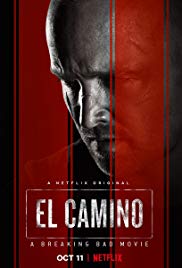Breaking Expectations: El Camino
November 15, 2019
It has been nine years after the jaw-dropping series finale of the critically acclaimed AMC series Breaking Bad, whose open-ended resolution left fans guessing the fate of the main characters: Jesse Pinkman (Aaron Paul) and Walter White (Bryan Cranston). While most presume that White had died since he was seen bleeding out in the show’s final scenes, Jesse’s fate was left a total mystery. The last we saw of Jesse was him driving away from captivity in a stolen pickup that gave the sequel its title: El Camino.
El Camino picks up right where Breaking Bad left off. Written and directed by the show’s creator, Vince Gilligan, the movie amusingly wraps up all of the series’ loose ends and gives fans one last taste of the infamous show they so dearly missed.
It is clear from the beginning that the Jesse in El Camino has drastically changed since his days on Breaking Bad. His year of imprisonment by a white-supremecist gang has made him less rowdy and cheerful- a result of the great agony over the trauma and abuse he endured. However, with this also comes a heightened sense of maturity and assertiveness; Jesse is not messing around.
Paul’s performance on Breaking Bad was often overshadowed by Cranston’s, but his performance in the sequel is exceptional. The film gives him plenty of room to shine, as much of the film solely focuses on Jesse. Paul does a wonderful job of portraying Jesse’s internal struggles and frustrations, further establishing himself as an unbelievably talented actor. It even feels plausible that the 40-year-old actor is playing a character in his mid-twenties, as the year of captivity appears to have taken such a toll on him.
The sequel also fulfills several “Breaking Bad-eque” features. Occasional bits of dry humor provide subtle yet pivotal relief to the grim and dismal storyline, specifically in the flashback to Todd’s (Jesse’s captor) apartment where Todd and Jesse had to dispose of his cleaning lady’s body. In this scene, Todd insists on making Jesse soup before doing anything about the rotting corpse in the kitchen. There’s also the use of suspense to build tension, such as in the scene whereJesse hides from two police officers as they search the apartment. Gilligan’s mastery of cinematography, including wide angles, time lapse and object point-of-views add on to the suspense in an aesthetically pleasing manner. There is also the incorporation of Western-style antics. In one scene, Jesse even engages in a quick-draw gunfight, giving the sequel a very Breaking Bad feel, while still maintaining its own distinction.
The film ends with Jesse in Alaska, a place he had talked about moving to, driving off into the hilly, snow-covered roads of his new home. However, most fans had predicted that this is where he would end up and the ending felt too easy. It is where I personally had hoped and convinced myself to believe that we would find Jesse after all of these years. So what was the point of confirming what most had already known?
I think what was more important was the life that he was escaping to. What kind of person is Jesse going to end up becoming? Will he start a new life, or resort back to the drug-business that has plagued his life for so long? Jesse has done some wrongs, but he was still the one with morals when compared to Walter White. He was afflicted by killing, cared for others and believed in mercy and forgiveness.
The show gives us the understanding that Jesse did not just escape incarceration; he escaped his violent, tormented past and began moving in a new direction, hopefully towards peace. I would definitely recommend this film, especially to those who were fans of Breaking Bad.
































